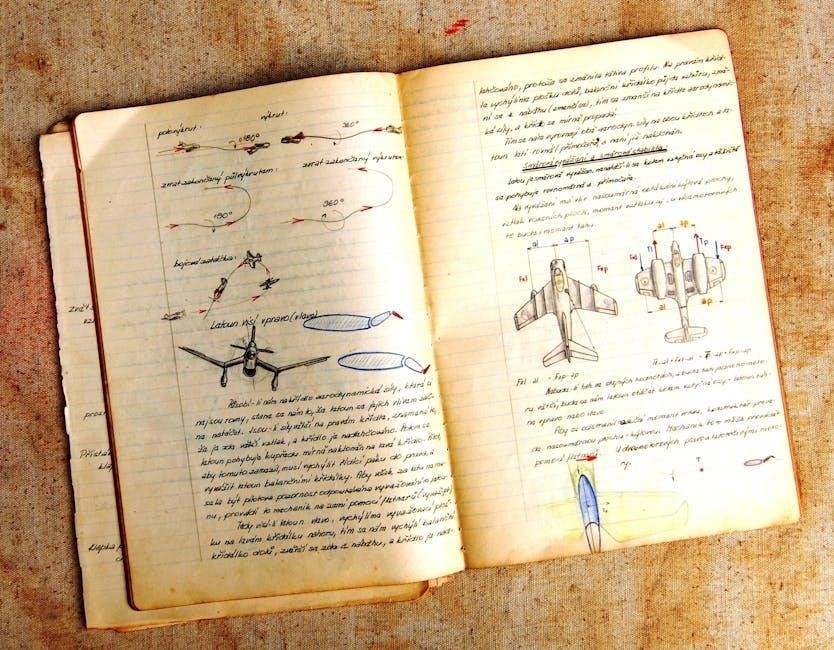
The B7 manual is a comprehensive guide for Audi B7 models‚ detailing maintenance‚ transmission‚ and troubleshooting procedures․ It helps owners understand and maintain their vehicles effectively‚ ensuring optimal performance and longevity․ Key topics include fluid changes‚ transmission swaps‚ and common issues‚ making it an invaluable resource for both new and experienced B7 enthusiasts․
Overview of the B7 Model
The Audi B7 model‚ part of the A4 series‚ represents a significant evolution in design and performance․ Introduced in the mid-2000s‚ it combines luxury‚ sportiness‚ and practicality‚ making it a favorite among automotive enthusiasts․ The B7 features a sleek exterior design‚ a refined interior‚ and advanced engine options‚ including petrol and diesel variants․ Its balanced handling and responsive steering contribute to a dynamic driving experience․ Available in both sedan and Avant (wagon) body styles‚ the B7 caters to diverse preferences․ With a strong focus on build quality and technology‚ the B7 has earned a reputation for reliability and longevity․ Its popularity endures‚ supported by a vibrant community of owners and enthusiasts who appreciate its blend of elegance and performance․

Importance of the Manual for B7 Owners
The B7 manual is an essential resource for owners‚ providing detailed insights into maintenance‚ troubleshooting‚ and performance optimization․ It serves as a comprehensive guide for understanding the vehicle’s systems‚ ensuring proper care and extending its lifespan․ By following the manual‚ owners can perform routine maintenance‚ such as fluid changes and inspections‚ to prevent costly repairs․ It also aids in diagnosing and addressing common issues‚ empowering owners to resolve problems independently․ The manual is crucial for maximizing the B7’s potential‚ ensuring reliability‚ and maintaining its value․ Whether for novice or experienced owners‚ it acts as a trusted reference‚ fostering a deeper connection with the vehicle and enhancing overall ownership satisfaction․

Key Features of the B7 Manual
The B7 manual highlights transmission specifications‚ engine compatibility‚ and design quality‚ offering detailed insights into performance‚ maintenance‚ and troubleshooting for optimal vehicle operation and longevity․
Transmission and Gearbox Specifications
The B7 manual provides detailed specifications for the transmission and gearbox‚ including compatibility with various engines and drivetrain configurations․ It outlines the 6-speed manual and automatic transmission options‚ highlighting gear ratios and torque capacity․ The manual also covers lubrication requirements‚ such as fluid types and change intervals‚ to ensure optimal performance․ Additionally‚ it discusses the design and build quality of the gearbox‚ emphasizing durability and precision engineering․ For enthusiasts considering upgrades or swaps‚ the manual offers insights into compatibility with aftermarket components․ Regular maintenance procedures‚ such as fluid checks and filter replacements‚ are detailed to prevent wear and extend the lifespan of the transmission system․ This section is essential for understanding and maintaining the B7’s transmission for smooth and reliable operation․
Engine Compatibility and Performance
The B7 manual details engine compatibility‚ ensuring owners understand which powertrains work seamlessly with their vehicle․ It covers both gasoline and diesel engine options‚ including the popular 2․0T and 3․0T variants․ The manual provides specifications for engine performance‚ torque output‚ and fuel efficiency‚ helping users optimize their driving experience․ For enthusiasts‚ it offers insights into engine swaps‚ such as the 2․7T conversion‚ and how to integrate these modifications․ Maintenance tips‚ like oil change intervals and filter replacements‚ are highlighted to preserve engine health․ The guide also explains how the manual transmission enhances engine performance through precise gear control․ By following the manual’s guidelines‚ B7 owners can maximize their engine’s potential and ensure long-term reliability․ This section is a must-read for anyone seeking to enhance or maintain their B7’s performance capabilities․
Design and Build Quality
The B7 manual highlights the robust design and exceptional build quality of the Audi B7 models‚ emphasizing attention to detail and premium materials․ The lightweight construction‚ combined with a durable frame‚ ensures long-term reliability and performance․ Owners can expect a seamless blend of functionality and aesthetics‚ with ergonomic design elements that enhance the driving experience․ The manual also covers the magnetic case attachment‚ which simplifies device handling while maintaining a sleek appearance․ Whether it’s the engine compartment or interior components‚ the B7’s design prioritizes both form and function‚ making it a standout choice for enthusiasts seeking a balance of power and sophistication․ This focus on quality ensures the B7 remains a reliable and visually appealing vehicle for years to come․

Maintenance and Servicing
Regular maintenance is crucial for the B7’s performance and longevity․ The manual provides detailed guidelines for fluid changes‚ inspections‚ and addressing common issues promptly to ensure reliability․
Fluid Change Procedures
Fluid changes are essential for maintaining the B7’s performance․ The manual details procedures for transmission‚ differential‚ and engine oils․ Transmission fluid should be replaced every 30‚000 to 60‚000 miles‚ while differential fluid is typically changed every 30‚000 miles․ Engine oil changes are recommended every 5‚000 to 7‚500 miles․ Proper tools and materials‚ such as a drain pan and socket set‚ are required․ Silicone-based oils are often suggested for lubrication during repairs․ Following the manual’s guidelines ensures optimal lubrication and prevents premature wear․ Regular fluid checks and changes help maintain smooth operation and extend the vehicle’s lifespan․ Always refer to the manual for specific intervals and recommendations tailored to your B7 model․
Recommended Maintenance Schedule
The B7 manual outlines a detailed maintenance schedule to ensure longevity and performance․ Regular oil changes are recommended every 5‚000 to 7‚500 miles‚ while spark plugs should be replaced every 50‚000 to 60‚000 miles․ Brake pads and rotors typically need inspection every 10‚000 miles․ Tire rotations should occur every 5‚000 to 8‚000 miles to ensure even wear․ Air filters should be replaced every 15‚000 to 30‚000 miles‚ depending on driving conditions․ Timing belts are usually replaced at 60‚000 to 105‚000 miles․ The manual also advises checking coolant‚ transmission‚ and differential fluids regularly․ Following this schedule helps prevent major issues and keeps the vehicle running smoothly․ Always consult the manual for model-specific recommendations and adjustments based on driving habits․
Common Parts and Replacements
The B7 manual highlights common parts that may require replacement to maintain optimal performance․ Spark plugs typically need replacing every 50‚000 to 60‚000 miles‚ while brake pads and rotors should be inspected and replaced as wear occurs․ Timing belts are critical and usually need replacement between 60‚000 to 105‚000 miles․ Transmission fluid and rear differential fluid are also common maintenance items‚ with recommendations for regular checks and changes․ Control arms and suspension components may wear over time and require replacement to ensure handling stability․ The manual emphasizes using OEM or high-quality aftermarket parts for reliability․ Consulting the manual for specific part numbers and replacement intervals is essential to avoid unnecessary repairs and ensure longevity․

Transmission and Manual Conversion
The B7 manual provides a detailed guide for transmission and manual conversion processes‚ ensuring smooth swaps and optimal performance․ It covers fluid changes‚ troubleshooting‚ and maintenance tips․
Understanding the Transmission System
The B7 manual delves into the intricacies of the transmission system‚ explaining how components like the gearbox‚ clutch‚ and driveshaft work together to transfer engine power to the wheels․ It highlights the importance of proper synchronization and gear engagement for smooth shifting․ The guide also covers differential operation and how it distributes power during acceleration and cornering․ Additionally‚ it provides insights into fluid lubrication and its role in maintaining transmission health․ By understanding these elements‚ owners can better appreciate the engineering behind their B7’s performance and handle maintenance or upgrades with confidence․ The manual emphasizes the need to consult specific diagrams and instructions for precise component identification and troubleshooting․

Manual Transmission Swap Guide
The B7 manual provides a detailed guide for swapping to a manual transmission‚ outlining essential steps to ensure compatibility and functionality․ It emphasizes the importance of pre-installation checks‚ such as verifying gear ratios and transmission mounts․ The guide also addresses common challenges‚ like wiring harness modifications and clutch pedal installation․ Specific attention is given to routing the reverse light switch and ensuring proper connector alignment․ Tools such as a T10 socket and transmission fluid are highlighted as critical for the process․ Additionally‚ the manual advises on post-installation testing‚ including gear engagement and fluid level checks․ For those tackling this project‚ the guide recommends consulting forums for real-world insights and tips to avoid common pitfalls․ Proper planning and execution are stressed to achieve a seamless conversion․
Troubleshooting Common Issues
The B7 manual provides detailed troubleshooting guidance for common issues‚ such as overboosting‚ electrical faults‚ and transmission problems․ It outlines diagnostic steps to identify root causes‚ like faulty vacuum lines or malfunctioning sensors․ For overboosting‚ the manual recommends checking the wastegate and turbocharger function․ Electrical issues are addressed with procedures for testing wiring harnesses and connectors․ Transmission-related problems‚ such as erratic shifting‚ are linked to fluid levels or solenoid malfunctions․ The guide also covers error codes‚ providing instructions for retrieving and interpreting them using diagnostic tools․ By following the manual’s troubleshooting steps‚ owners can resolve issues efficiently‚ ensuring optimal performance and preventing further damage․ Regular checks and preventive maintenance are emphasized to minimize potential problems․

Troubleshooting and Repair
The B7 manual offers detailed repair guidance‚ focusing on diagnosing and resolving issues like transmission faults‚ electrical malfunctions‚ and engine performance problems․ It provides step-by-step solutions to ensure proper fixes and prevent further damage‚ emphasizing the use of diagnostic tools and manufacturer-recommended practices for reliable outcomes․ Regular maintenance and inspections are also highlighted to minimize the risk of mechanical failures‚ ensuring the vehicle runs smoothly and efficiently over time․ The manual serves as a go-to resource for addressing common and complex issues‚ tailored for both DIY enthusiasts and professional mechanics․ Its clear instructions and troubleshooting charts make it an essential tool for maintaining the B7 model․
Diagnosing Overboosting Problems
Diagnosing overboosting issues in the B7 manual involves checking the boost sensor‚ wastegate‚ and intercooler․ Common causes include faulty sensors‚ clogged intercoolers‚ or malfunctioning wastegates․ Drivers may notice excessive turbo pressure or engine light activation․ The manual recommends using diagnostic tools like VCDS to scan for fault codes related to boost pressure․ Inspecting the wastegate actuator and vacuum hoses is crucial‚ as leaks or mechanical failures can lead to overboosting․ Additionally‚ ensuring proper turbocharger function and checking for blockages in the intake system are essential steps․ If issues persist‚ consulting a professional mechanic is advised to prevent engine damage․ The manual provides detailed troubleshooting charts to help identify and resolve overboosting problems effectively‚ ensuring optimal engine performance and longevity․ Regular inspections and maintenance can help prevent such issues from arising․
Electrical System Diagnostics

Diagnosing electrical system issues in the B7 manual involves checking for fault codes using tools like VCDS․ Common problems include faulty sensors‚ wiring issues‚ or malfunctioning fuses․ Drivers may notice warning lights or erratic electrical behavior․ The manual recommends inspecting the battery‚ alternator‚ and wiring connections for corrosion or damage․ Testing voltage levels at key components can help identify shorts or open circuits․ Addressing electrical issues promptly is crucial to prevent further damage․ Regular inspections of the electrical system can help avoid unexpected failures․ The manual provides detailed diagnostic charts to help pinpoint and resolve electrical faults efficiently‚ ensuring reliable vehicle operation․
Addressing Common Fault Codes
The B7 manual outlines procedures for identifying and resolving common fault codes․ Using tools like VCDS‚ owners can retrieve codes from the vehicle’s ECU․ Common issues such as P0171 (system too lean) or P0300 (random misfire) are often caused by vacuum leaks or faulty oxygen sensors․ The manual provides step-by-step guidance for diagnosing and repairing these faults․ It also emphasizes the importance of resetting codes after repairs to ensure proper system operation․ Regular scanning for fault codes can help prevent minor issues from becoming major problems․ By following the manual’s instructions‚ B7 owners can effectively address electrical and engine-related faults‚ maintaining their vehicle’s performance and reliability․

User Experiences and Tips
Owners share insights on B7 maintenance and modifications․ Community feedback highlights practical advice for optimizing performance and addressing common issues․ Real-world tips enhance ownership experiences and reliability․
Community Feedback and Reviews
Owners and enthusiasts have shared valuable insights about the B7 manual‚ emphasizing its clarity and practicality․ Many highlight how the manual aids in troubleshooting common issues like overboosting and transmission problems․ Positive reviews often mention the detailed fluid change procedures and maintenance schedules‚ which ensure longevity․ Some users praise the guide for simplifying complex tasks‚ such as manual transmission swaps․ Feedback also includes tips for optimizing performance and addressing fault codes․ Overall‚ the B7 manual is regarded as an essential resource‚ helping owners enhance their driving experience and maintain their vehicles efficiently․
Practical Advice for B7 Owners
B7 owners often recommend regular fluid changes‚ particularly for the transmission and rear differential‚ to maintain smooth performance․ Manual transmission swaps are common‚ and experts suggest using high-quality synthetic fluids for optimal lubrication․ Many advise checking for worn parts during such swaps to prevent future issues․ Additionally‚ owners emphasize the importance of following the recommended maintenance schedule to avoid costly repairs․ Practical tips include monitoring dashboard warning lights and addressing fault codes promptly․ For those considering modifications‚ consulting forums or specialists is highly recommended․ Regular inspections of the transmission and engine components can significantly extend the vehicle’s lifespan․ By following these guidelines‚ B7 owners can ensure their car runs efficiently and reliably for years to come․
Real-World Performance Insights
Owners of the B7 model have reported impressive real-world performance‚ particularly with manual transmission swaps‚ which enhance acceleration and driver control․ The vehicle’s engine compatibility and tuning potential make it a favorite among enthusiasts․ Many note that proper maintenance‚ such as regular fluid changes‚ significantly improves handling and responsiveness․ Real-world testing shows that the B7’s performance remains consistent even under heavy use‚ making it a reliable choice for daily driving․ Practical modifications‚ like upgrading the transmission or adjusting the suspension‚ can further enhance its capabilities․ Overall‚ the B7 delivers a balanced blend of power and practicality‚ making it a standout in its class for both enthusiasts and everyday drivers․

Evolution and Future Updates
The B7 model has evolved significantly‚ with advancements in transmission systems and engine compatibility․ Future updates promise enhanced performance‚ efficiency‚ and innovative features‚ keeping the B7 competitive and relevant․
Historical Development of the B7
The Audi B7 platform‚ introduced in 2004‚ marked a significant milestone in the evolution of the A4 series․ Known for its sleek design and enhanced performance‚ the B7 quickly gained popularity among automotive enthusiasts․ It featured a robust 2․7L twin-turbo engine and a refined manual transmission system‚ making it a favorite for drivers seeking both power and precision․ Over the years‚ the B7 underwent several updates‚ including improvements to its transmission and gearbox‚ ensuring it remained competitive in the market․ The B7’s legacy is celebrated for its balance of style‚ functionality‚ and driving dynamics‚ solidifying its place in Audi’s history․ Its influence continues to inspire modern updates and enthusiasts’ modifications․
Upcoming Features and Enhancements
Audi continues to innovate‚ with plans to introduce advanced features for the B7 model․ Future updates may include refined transmission software for smoother shifting and enhanced engine efficiency․ Design improvements could focus on lightweight materials and aerodynamics․ Additionally‚ Audi is exploring eco-friendly enhancements to improve fuel efficiency without compromising performance․ The manufacturer is also considering feedback from the B7 community to address common issues like reverse light functionality post-manual swaps․ Expect more comprehensive diagnostic tools and updated manuals to aid owners․ These updates aim to keep the B7 competitive and user-friendly‚ ensuring it remains a favorite among enthusiasts․ Stay tuned for official releases from Audi․
Stay Updated with Manufacturer Releases
Keeping up with the latest updates from Audi is essential for optimizing your B7 experience․ The manufacturer regularly releases firmware updates and service bulletins to enhance performance and address common issues․ These updates often include improvements for transmission functionality‚ engine efficiency‚ and diagnostic tools․ Audi may also introduce new features based on owner feedback‚ such as refined software for smoother shifting or enhanced troubleshooting guides․ Stay informed by checking Audi’s official website or authorized service centers for the latest releases․ Additionally‚ community forums and enthusiast groups often share insights and tips on implementing these updates effectively․ Regularly reviewing manufacturer communications ensures your B7 remains up-to-date and performs at its best․